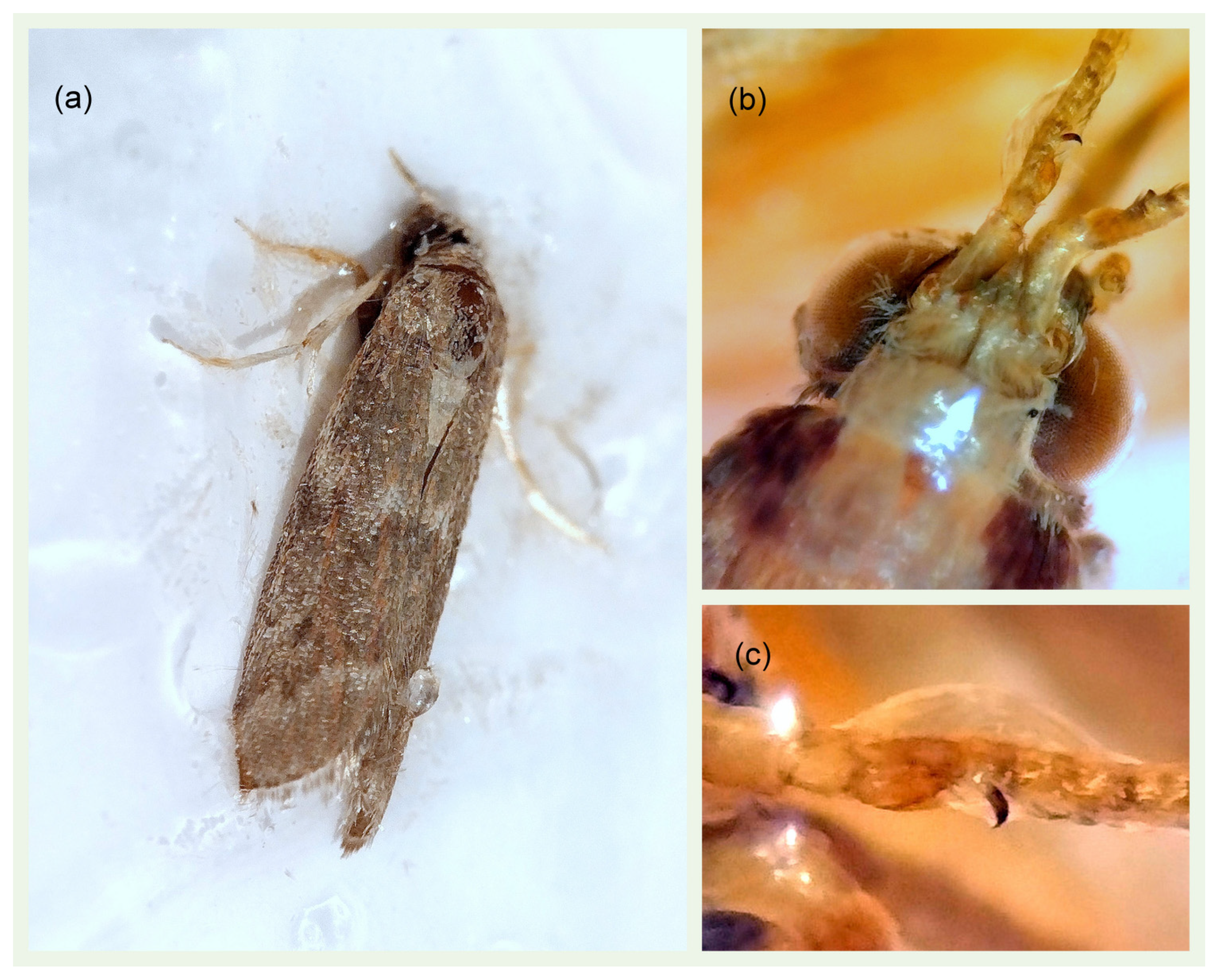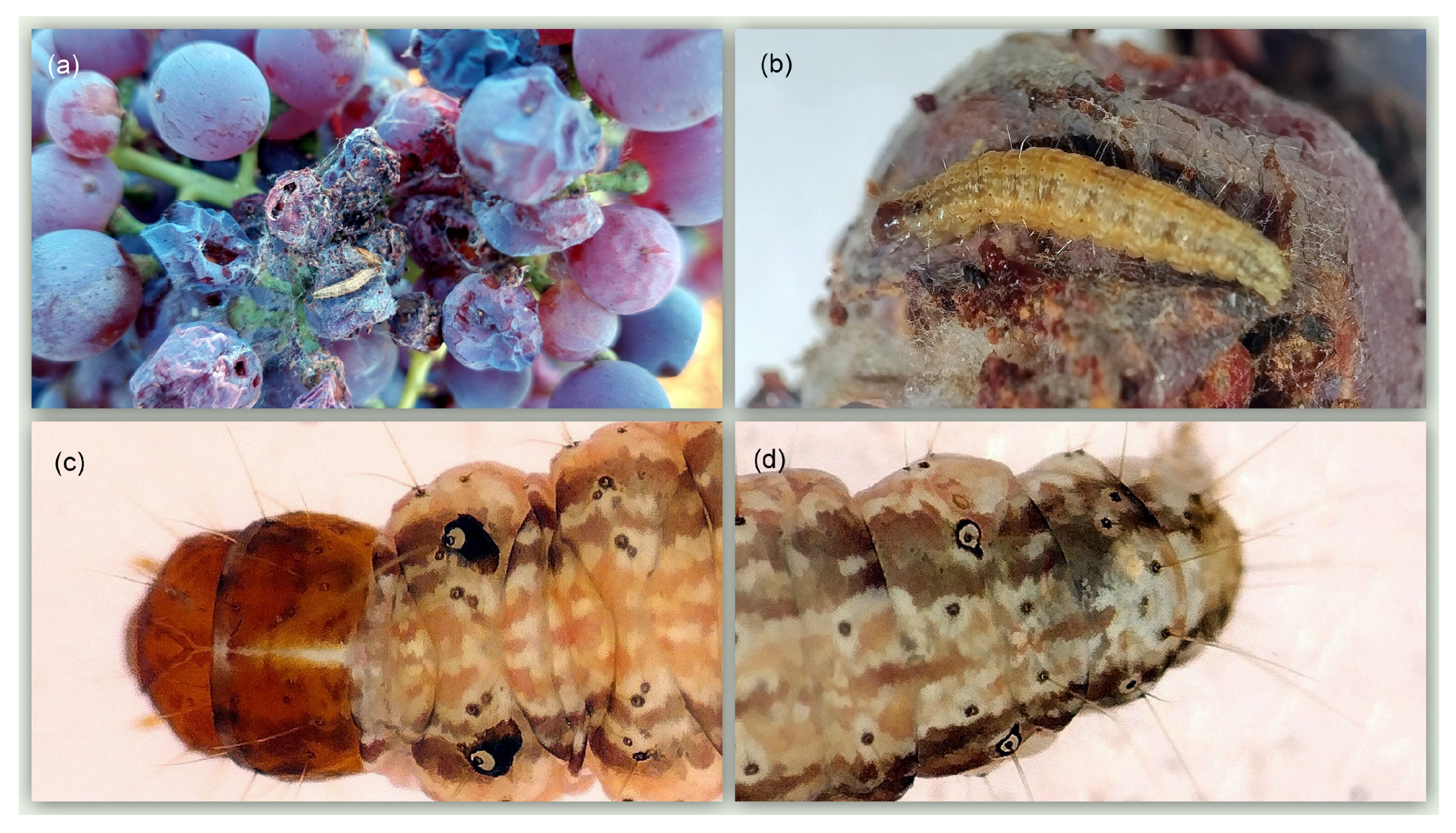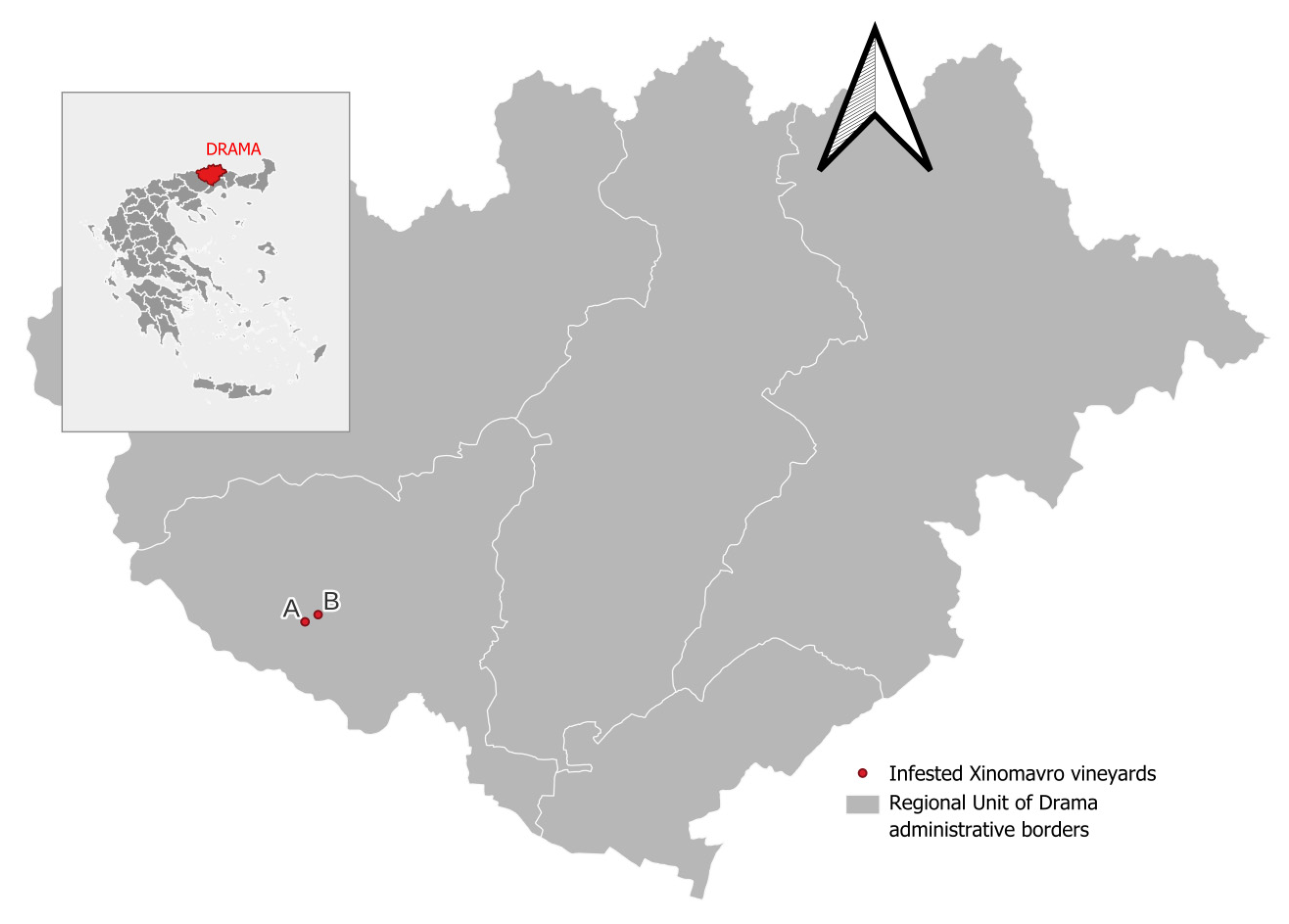Cryptoblabes gnidiella Millière (Pyralidae, Phycitinae): An Emerging Grapevine Pest in Greece
Simple Summary
Abstract
1. Introduction
2. Materials and Methods
2.1. Monitoring and Sampling Locations
2.2. Species Identification
2.3. Assessment of the Damage Extent
3. Results
3.1. Species Identification
3.2. Monitoring of Flight in Pheromone Traps
3.3. Description of the Damage
3.4. Estimation of the Damage Level
4. Discussion
5. Conclusions
Author Contributions
Funding
Data Availability Statement
Acknowledgments
Conflicts of Interest
References
- Aitken, A.D. A Key to the Larvae of Some Species of Phycitinae (Lepidoptera, Pyralidae) Associated with Stored Products, and of Some Related Species. Bull. Entomol. Res. 1963, 54, 175–188. [Google Scholar] [CrossRef]
- Triplehorn, C.A.; Johnson, N.F.; Borror, D.J. Borror and DeLong’s Introduction to the Study of Insects, 7th ed.; Thompson Brooks/Cole: Belmont, CA, USA, 2006; ISBN 978-0-03-096835-8. [Google Scholar]
- Liu, C.; Yang, M.; Li, M.; Jin, Z.; Yang, N.; Yu, H.; Liu, W. Climate Change Facilitates the Potentially Suitable Habitats of the Invasive Crop Insect Ectomyelois ceratoniae (Zeller). Atmosphere 2024, 15, 119. [Google Scholar] [CrossRef]
- Pachkin, A.; Kremneva, O.; Leptyagin, D.; Ponomarev, A.; Danilov, R. Light Traps to Study Insect Species Diversity in Soybean Crops. Agronomy 2022, 12, 2337. [Google Scholar] [CrossRef]
- Simoglou, K.B.; Karataraki, A.; Roditakis, N.E.; Roditakis, E. Euzophera bigella (Zeller) (Lepidoptera: Pyralidae) and Dasineura Oleae (F. Low) (Diptera: Cecidomyiidae): Emerging Olive Crop Pests in the Mediterranean? J. Pest Sci. 2012, 85, 169–177. [Google Scholar] [CrossRef]
- Powell, J.A. Lepidoptera (Moths, Butterflies). In Encyclopedia of insects, 2nd ed.; Cardé, R.T., Resh, V.H., Eds.; Elsevier/Academic Press: Amsterdam, The Netherlands; London, UK, 2009. [Google Scholar]
- Benelli, G.; Lucchi, A.; Anfora, G.; Bagnoli, B.; Botton, M.; Campos-Herrera, R.; Carlos, C.; Daugherty, M.P.; Gemeno, C.; Harari, A.R.; et al. European Grapevine Moth, Lobesia botrana Part I: Biology and Ecology. Entomologia 2023, 43, 261–280. [Google Scholar] [CrossRef]
- Benelli, G.; Lucchi, A.; Anfora, G.; Bagnoli, B.; Botton, M.; Campos-Herrera, R.; Carlos, C.; Daugherty, M.P.; Gemeno, C.; Harari, A.R.; et al. European Grapevine Moth, Lobesia botrana Part II: Prevention and Management. Entomologia 2023, 43, 281–304. [Google Scholar] [CrossRef]
- Varikou, K.; Birouraki, A.; Bagis, N.; Kontodimas, D.C. Effect of Temperature on the Development and Longevity of Planococcus ficus (Hemiptera: Pseudococcidae). Ann. Entomol. Soc. Am. 2010, 103, 943–948. [Google Scholar] [CrossRef]
- Karamaouna, F.; Menounou, G.; Stathas, G.J.; Avtzis, D.N. First record and molecular identifi cation of the parasitoid Anagyrus sp. near pseudococci Girault (Hymenoptera: Encyrtidae) in Greece—Host size preference for the vine mealybug Planococcus ficus (Signoret) (Hemiptera: Pseudococcidae). Hell. Plant Prot. J. 2011, 4, 45–52. Available online: https://www.hppj.gr/wp-content/uploads/2015/02/Volume-4-Issue-2-July-2011.pdf (accessed on 13 October 2024).
- Evangelou, V.; Lytra, I.; Krokida, A.; Antonatos, S.; Georgopoulou, I.; Milonas, P.; Papachristos, D.P. Insights into the Diversity and Population Structure of Predominant Typhlocybinae Species Existing in Vineyards in Greece. Insects 2023, 14, 894. [Google Scholar] [CrossRef]
- Roditakis, N.E. First Record of Frαnkliniellα occidentαlis in Greece. Entomol. Hell. 1991, 9, 77. [Google Scholar] [CrossRef][Green Version]
- Roditakis, E.; Roditakis, N.E. Assessment of the Damage Potential of Three Thrips Species on White Variety Table Grapes—In Vitro Experiments. Crop Prot. 2007, 26, 476–483. [Google Scholar] [CrossRef]
- Bagnoli, B.; Lucchi, A. Bionomics of Cryptoblabes gnidiella (Milliθre) (Pyralidae Phycitinae) in Tuscan vineyards. IOBC/WPRS Bull. 2001, 24, 79–84. Available online: https://iobc-wprs.org/product/iobc-wprs-bulletin-vol-24-7-2001/ (accessed on 13 October 2024).
- Lucchi, A.; Ricciardi, R.; Benelli, G.; Bagnoli, B. What Do We Really Know on the Harmfulness of Cryptoblabes gnidiella (Milliθre) to Grapevine? From Ecology to Pest Management. Phytoparasitica 2019, 47, 1–15. [Google Scholar] [CrossRef]
- Ricciardi, R.; Di Giovanni, F.; Cosci, F.; Ladurner, E.; Savino, F.; Iodice, A.; Benelli, G.; Lucchi, A. Mating Disruption for Managing the Honeydew Moth, Cryptoblabes gnidiella (Milliθre), in Mediterranean Vineyards. Insects 2021, 12, 390. [Google Scholar] [CrossRef]
- French Institute of Vine and Wine. The economic cost of Cryptoblabes gniediella. Institut Franηais de la Vigne et du Vin. 2024. Available online: https://www.vignevin.com/article/le-cout-economique-de-cryptoblabes-gniediella/ (accessed on 26 October 2024).
- Avidov, Z.; Gothilf, S. Observations on the honeydew moth (Cryptoblabes gnidiella Milliere) in Israel. Ktavim 1960, 10, 109–124. Available online: https://download.ceris.purdue.edu/file/2088 (accessed on 13 October 2024).
- Dawidowicz, Ł.; Rozwałka, R. Honeydew Moth Cryptoblabes gnidiella (MILLIΘRE, 1867) (Lepidoptera: Pyralidae): An Adventive Species Frequently Imported with Fruit to Poland. Pol. J. Entomol. 2016, 85, 181–189. [Google Scholar] [CrossRef][Green Version]
- Elnagar, H. Population Dynamic of Honeydew Moth, Cryptoblabes gnidiella Miller in Vineyards Orchards. Egypt. Acad. J. Biol. Sci. A Entomol. 2018, 11, 73–78. [Google Scholar] [CrossRef]
- Velez-Gavilan, J. Cryptoblabes Gnidiella (Honeydew Moth); CABI: Wallingford, UK, 2022; p. 16381. Available online: https://www.cabidigitallibrary.org/doi/10.1079/cabicompendium.16381 (accessed on 13 October 2024).
- Karsholt, O.; Razowski, J. The Lepidoptera of Europe: A Distributional Checklist; Apollo books: Stenstrup, Denmark, 1996; ISBN 978-87-88757-01-9. [Google Scholar]
- Neunzig, H.H. The Moths of America, North of Mexico. Fasc. 15,2: Fasc. 15. Pyraloidea/H. H. Neunzig Pyralidae (Pt.), Phycitinae (Pt.); Neunzig, H.H., Ed.; Classey: London, UK, 1986; ISBN 978-0-933003-01-9. [Google Scholar]
- Ioriatti, C.; Lucchi, A.; Varela, L.G. Grape Berry Moths in Western European Vineyards and Their Recent Movement into the New World. In Arthropod Management in Vineyards; Bostanian, N.J., Vincent, C., Isaacs, R., Eds.; Springer Netherlands: Dordrecht, The Netherlands, 2012; pp. 339–359. ISBN 978-94-007-4031-0. [Google Scholar]
- Elekcioglu, N.Z.; Olculu, M. Pest, predator and parasitoid species in persimmon orchards in the eastern Mediterranean region of Turkey, with new records. Fresenius Environ. Bull. 2017, 26, 5170–5176. [Google Scholar]
- Harari, A.R.; Zahavi, T.; Gordon, D.; Anshelevich, L.; Harel, M.; Ovadia, S.; Dunkelblum, E. Pest Management Programmes in Vineyards Using Male Mating Disruption. Pest Manag. Sci. 2007, 63, 769–775. [Google Scholar] [CrossRef]
- Keçeci̇, M. The Population Dynamic of Honeydew Moth [Cryptoblabes Gnidiella Mill. (Lepidoptera: Pyralidae)] in Vineyard in Antalya. Mediterr. Agric. Sci. 2021, 34, 169–173. [Google Scholar] [CrossRef]
- Vidart, M.V.; Mujica, M.V.; Calvo, M.V.; Duarte, F.; Bentancourt, C.M.; Franco, J.; Scatoni, I.B. Relationship between Male Moths of Cryptoblabes gnidiella (Milliθre) (Lepidoptera: Pyralidae) Caught in Sex Pheromone Traps and Cumulative Degree-Days in Vineyards in Southern Uruguay. SpringerPlus 2013, 2, 258. [Google Scholar] [CrossRef] [PubMed]
- JASP Team. JASP (Version 0.19.3)—Computer Software. Available online: https://jasp-stats.org (accessed on 22 November 2024).
- Folmer, O.; Black, M.; Hoeh, W.; Lutz, R.; Vrijenhoek, R. DNA primers for amplification of mitochondrial cytochrome c oxidase subunit I 273 from diverse Metazoan invertebrates. Mol. Mar. Biol. Biotechnol. 1994, 3, 294–299. [Google Scholar] [PubMed]
- Avtzis, D.N.; Markoudi, V.; Mizerakis, V.; Devalez, J.; Nakas, G.; Poulakakis, N.; Petanidou, T. The Aegean Archipelago as Cradle: Divergence of the Glaphyrid Genus Pygopleurus and Phylogeography of P. Foina. Syst. Biodivers. 2021, 19, 346–358. [Google Scholar] [CrossRef]
- Sadras, V.O.; Petrie, P.R. Climate Shifts in South-Eastern Australia: Early Maturity of Chardonnay, Shiraz and Cabernet Sauvignon Is Associated with Early Onset Rather than Faster Ripening: Climate Shifts and Grapevine Ripening. Aust. J. Grape Wine Res. 2011, 17, 199–205. [Google Scholar] [CrossRef]
- Zumbado-Ulate, H.; Schartel, T.E.; Simmons, G.S.; Daugherty, M.P. Assessing the Risk of Invasion by a Vineyard Moth Pest Guild. NeoBiota 2023, 86, 169–191. [Google Scholar] [CrossRef]
- Moschos, T.; Souliotis, C.; Broumas, T.; Kapothanassi, V. Control of the European Grapevine moth Lobesia botrana in Greece by the Mating Disruption Technique: A Three-Year Survey. Phytoparasitica 2004, 32, 83–96. [Google Scholar] [CrossRef]
- Daane, K.M.; Yokota, G.Y.; Walton, V.M.; Hogg, B.N.; Cooper, M.L.; Bentley, W.J.; Millar, J.G. Development of a Mating Disruption Program for a Mealybug, Planococcus ficus, in Vineyards. Insects 2020, 11, 635. [Google Scholar] [CrossRef]
- Mondani, L.; Palumbo, R.; Tsitsigiannis, D.; Perdikis, D.; Mazzoni, E.; Battilani, P. Pest Management and Ochratoxin A Contamination in Grapes: A Review. Toxins 2020, 12, 303. [Google Scholar] [CrossRef]
- Ringenberg, R.; Botton, M.; Garcia, M.S.; Nondillo, A. Biologia Comparada e Exigκncias Tιrmicas de Cryptoblabes gnidiella Em Dieta Artificial. Pesq. Agropec. Bras. 2005, 40, 1059–1065. [Google Scholar] [CrossRef]
- Öztürk, N. Creating a Degree-Day Model of Honeydew Moth [Cryptoblabes Gnidiella (Mill., 1867) (Lepidoptera: Pyralidae)] in Pomegranate Orchards. Turk. J. Entomol. 2018, 42, 53–62. [Google Scholar] [CrossRef]
- Wysoki, M.; Ben Yehuda, S.; Rosen, D. Reproductive Behavior of the Honeydew Moth, Cryptoblabes gnidiella. Invertebr. Reprod. Dev. 1993, 24, 217–223. [Google Scholar] [CrossRef]
- Acin, P. Management of the honeydew moth by mating disruption in vineyard. IOBC/WPRS Bull. 2019, 146, 28–31. Available online: https://iobc-wprs.org/product/iobc-wprs-bulletin-vol-146-2019-copy/ (accessed on 13 October 2024).
- Reineke, A.; Thiιry, D. Grapevine Insect Pests and Their Natural Enemies in the Age of Global Warming. J. Pest Sci. 2016, 89, 313–328. [Google Scholar] [CrossRef]
- Caffarra, A.; Rinaldi, M.; Eccel, E.; Rossi, V.; Pertot, I. Modelling the Impact of Climate Change on the Interaction between Grapevine and Its Pests and Pathogens: European Grapevine Moth and Powdery Mildew. Agric. Ecosyst. Environ. 2012, 148, 89–101. [Google Scholar] [CrossRef]




Disclaimer/Publisher’s Note: The statements, opinions and data contained in all publications are solely those of the individual author(s) and contributor(s) and not of MDPI and/or the editor(s). MDPI and/or the editor(s) disclaim responsibility for any injury to people or property resulting from any ideas, methods, instructions or products referred to in the content. |
© 2025 by the authors. Licensee MDPI, Basel, Switzerland. This article is an open access article distributed under the terms and conditions of the Creative Commons Attribution (CC BY) license (https://creativecommons.org/licenses/by/4.0/).
Share and Cite
Simoglou, K.B.; Topalidis, I.; Avtzis, D.N.; Kaltsidis, A.; Roditakis, E. Cryptoblabes gnidiella Millière (Pyralidae, Phycitinae): An Emerging Grapevine Pest in Greece. Insects 2025, 16, 63. https://doi.org/10.3390/insects16010063
Simoglou KB, Topalidis I, Avtzis DN, Kaltsidis A, Roditakis E. Cryptoblabes gnidiella Millière (Pyralidae, Phycitinae): An Emerging Grapevine Pest in Greece. Insects. 2025; 16(1):63. https://doi.org/10.3390/insects16010063
Chicago/Turabian StyleSimoglou, Konstantinos B., Iraklis Topalidis, Dimitrios N. Avtzis, Achilleas Kaltsidis, and Emmanouil Roditakis. 2025. "Cryptoblabes gnidiella Millière (Pyralidae, Phycitinae): An Emerging Grapevine Pest in Greece" Insects 16, no. 1: 63. https://doi.org/10.3390/insects16010063
APA StyleSimoglou, K. B., Topalidis, I., Avtzis, D. N., Kaltsidis, A., & Roditakis, E. (2025). Cryptoblabes gnidiella Millière (Pyralidae, Phycitinae): An Emerging Grapevine Pest in Greece. Insects, 16(1), 63. https://doi.org/10.3390/insects16010063







